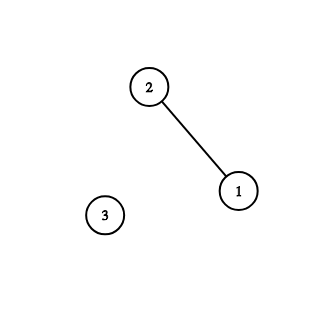You are given a set of size $m$ with integer elements between $0$ and $2^{n}-1$ inclusive. Let’s build an undirected graph on these integers in the following way: connect two integers $x$ and $y$ with an edge if and only if $x \& y = 0$. Here $\&$ is the bitwise AND operation. Count the number of connected components in that graph.
Input
In the first line of input there are two integers $n$ and $m$ ($0 \le n \le 22$, $1 \le m \le 2^{n}$).
In the second line there are $m$ integers $a_1, a_2, \ldots, a_m$ ($0 \le a_{i} < 2^{n}$) — the elements of the set. All $a_{i}$ are distinct.
Output
Print the number of connected components.
Examples
input
2 3
1 2 3
output
2
input
5 5
5 19 10 20 12
output
2
Note
Graph from first sample:

Graph from second sample:

Solution:
#include <bits/stdc++.h>
using namespace std;
int main() {
ios::sync_with_stdio(false);
cin.tie(0);
int n, m;
cin >> n >> m;
vector<int> was(1 << n, 1);
for (int i = 0; i < m; i++) {
int x;
cin >> x;
was[x] = 0;
}
vector<int> used(1 << n, 0);
vector<int> que(1 << n);
vector<int> inner(1 << n);
int ans = 0;
for (int start = 0; start < (1 << n); start++) {
if (was[start]) {
continue;
}
ans++;
was[start] = 1;
que[0] = start;
int qs = 1;
for (int q = 0; q < qs; q++) {
int u = (1 << n) - 1 - que[q];
if (!used[u]) {
used[u] = 1;
inner[0] = u;
int is = 1;
for (int i = 0; i < is; i++) {
int z = inner[i];
if (!was[z]) {
was[z] = 1;
que[qs++] = z;
}
for (int bit = 0; bit < n; bit++) {
if ((z & (1 << bit)) && !used[z ^ (1 << bit)]) {
used[z ^ (1 << bit)] = 1;
inner[is++] = z ^ (1 << bit);
}
}
}
}
}
}
cout << ans << '\n';
return 0;
}
Related posts:
Robot Rapping Results Report
Foo Fighters
Koala and Lights
Points on Line
Graph Coloring
Flowers and Chocolate
Infinite Path
Frog Jumping
Ordering T-Shirts
New Year and Three Musketeers
A Game on Strings
Chip Game
Modernization of Treeland
Idempotent functions
Command Line Arguments
The Tower is Going Home
Fish Weight
Simple Skewness
Reach Median
Well-known Numbers
Check if two segments intersect
Breadth-first search
Pavel and Triangles
Kuroni the Private Tutor
Again?
Floyd-Warshall - finding all shortest paths
Adam and Tree
Finding the equation of a line for a segment
Fast Fourier transform
Dima and Horses
Pick's Theorem - area of lattice polygons
Minimum spanning tree - Kruskal with Disjoint Set Union

